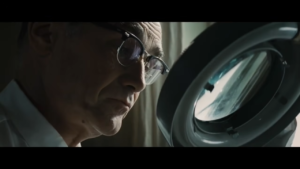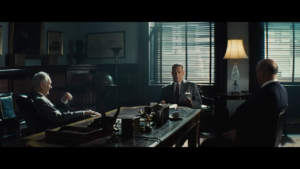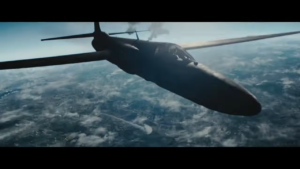Rating: 4.25 out of 5




![]()
If you are old enough to remember or studied it in school, history talks about the Cold War after WWII. For a quick history lesson, the Cold War was a period of political tension between superpowers, the United States and the Soviet Union. Many of their respective allies joined each side, one being the Western Bloc and the other called the Eastern Bloc. From reading, many don’t know the exact dates, but some associate them around the Truman Doctrine on 12 March 1947 to the dissolution of the Soviet Union on 26 December 1991. Even though no actual war was fought between the two powers, it was primarily based on the ideological and geopolitical struggle for global influence of the two superpowers. Also, during this time, the race for nuclear arms became high, and spies from each country were used heavily to gain a significant step up. One area that was affected the most was Berlin. The Belin Wall was erected and divided the city from 1961 to 1989, as well as encircling and separating West Berlin from East German territory.

Directed by the great Steven Spielberg, written by Matt Charman and the Coen brothers, Bridge of Spies is a film where prisoner exchange becomes the forefront. In 1957, Rudolf Abel (Rylance) was arrested and charged with spying for the Soviet Union during the Cold War and in NYC. Insurance lawyer James B. Donovan (Hanks) is appointed legal counsel for Rudolf. As a moral and ethical man, Donovan believes that the accused deserves the best defense possible and declines to cooperate with the CIA, along with arguing with judges who believe Rudolf deserves the death penalty. During this time, Donovan and his family are constantly harassed as many believe he is a traitor for defending Rudolf. Donovan manages to convince the judge to remove the death penalty because Abel had been serving his country honorably, and he might prove useful for a future prisoner exchange. The judge sentences Rudolf to 30 years in prison. In 1960, Gary Powers, a pilot in the CIA’s top-secret U-2 spy plane program, was shot down over the USSR. Powers is captured and, in a show trial, is sentenced to ten years in confinement. Pretty much, shit just got real. Believing that Powers would give up valuable information, the CIA summoned Donovan to help negotiate the exchange of the two spies. While over in Berlin, Donovan learns that the American student Frederic Pryor was arrested on the border of East Berlin while trying to bring his German girlfriend to West Berlin. Donovan includes Pryor in the negotiations, but it is met by heavy resistance from the CIA, who only want Powers. Will Donovan have the negotiation skills to succeed with two prisoners on opposite ends?

I have to give props to Steven Spielberg on this one. The man knows how to direct. How can one take a situation with absolutely zero action during the Cold War and make it entertaining? Not just the okay, this is good but having the sense that you don’t know if Donovan can pull off the negotiations. None of the characters really pull you in and make you excited. They all are relatively calm with few voices raised, but Spielberg’s eye and direction pull you into the story from the atmosphere and what is going on.
Spielberg takes his time building the atmosphere and the characters rather than having large explosions. Rudolf seems like a simple man. He is first shown doing a painting, and then he gets a package where you see its spy information. I believe it was a nickel. A freakin hollow nickel. You know how creative that is to pass along spy stuff through a hollow nickel. In another scene, Donovan arrives in Berlin. He has to pay a “coat” tax, but the most action you see with him is when he is riding the train and sees people trying to escape only to be shot. Once again, not much action, but it keeps you involved as you want to see how Donovan can pull this off.

I want to take a moment to discuss the aesthetic of this film. It has that dark, gloomy, but the 50s feel to it. It seems like it was done without anything happy and bright. Now that I think about it, it has a depressing feel. The sense that nothing good is going to happen is all around. The Berlin wall is rising, and everyone is trying to figure out what will happen. Donovan’s family is harassed at night with brinks and gunshots. Finally, the climax, where you don’t know if anyone will keep their end of the bargain. Yet, at the very end, the scenes brighten up. When Donovan comes home and passes out, you see that he gets the credit he rightfully deserves.
As far as the cast goes, the two main actors need to be given props in this film. Tom Hanks as James B. Donovan was Tom Hanks. He is a brilliant actor who just has a calm presence about him. It’s surprising because he cusses, and I’m like, “Tom Hanks doesn’t cuss!” Mark Rylance, as Rudolf Abel, was a man who wasn’t overly out there. He was really calm and didn’t seem upset at all. He didn’t yell or scream that he was innocent. He was pretty much, I am going to let you handle it, and whatever happens, happens.
Bridge of Spies is one of those films that doesn’t have any action but draws one in with the story, direction, and acting. Is it one of Spielberg’s greatest films ever? Hell no, but it shows that Spielberg can still direct and tell a story. Hanks and Rylance are excellent in this film and use their performances to move this film forward. If you are in the mood for a Cold War film, this is a pretty good one to start with.